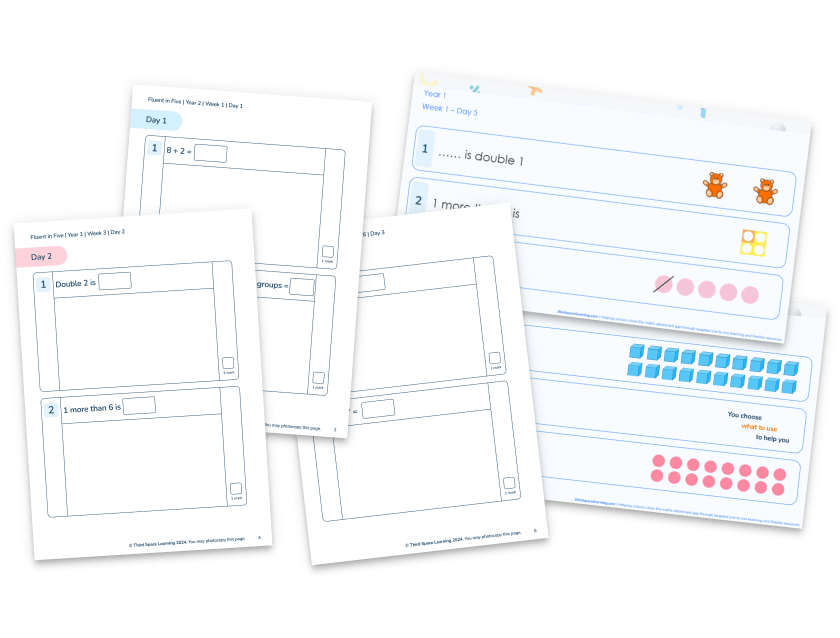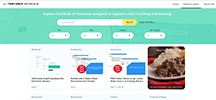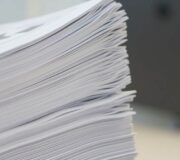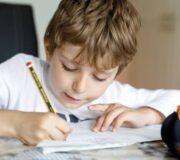Year 6 Maths Curriculum Toolkit: Planning & Resources
Year 6 maths can bring a surge of anxiety as the final year of primary school. It’s a big step up, culminating in high-stakes tests like the SATs, and it can feel overwhelming for children and teachers alike. Pupils need to master complex topics – from long division to fractions, decimals, and percentages – all while preparing for the leap to secondary school. This transition can be a stressful time, making focused, effective support essential.
As specialists in primary maths education, we at Third Space Learning have supported thousands of 10 and 11-year-olds through this critical phase. We understand the specific demands of the Year 6 maths national curriculum and the challenge of preparing for the two arithmetic and one reasoning SATs papers. Our expertise, developed over a decade, is rooted in helping pupils secure deep conceptual understanding and build the confidence necessary to tackle these challenging exams.
This comprehensive guide is designed to be your definitive resource for all things Year 6 maths. You’ll gain a clear breakdown of the core topics, practical advice, and proven strategies to support your child’s learning journey. Get ready to explore free resources, effective activities, Year 6 maths worksheets, a Year 6 maths test and expert tips, all to ensure pupils are not just ready for the SATs, but confidently prepared for the transition to Year 7 maths and beyond.
What the Year 6 Maths curriculum says
Key skills for Year 6 maths
- Extending the number system: Pupils solidify their understanding of the number system and place value, working with integers up to 10 million.
- Making connections (FDP & Ratio): Teaching must develop the links between multiplication and division with Fractions, Decimals, Percentages, and Ratios.
- Problem-Solving Strategies: Key strategies include breaking down problems, using visual aids, and strengthening the foundation in Fractions, Decimals, and complex problem-solving.
- Efficient Calculation: Pupils must develop their ability to solve increasingly complex problems using efficient written and mental methods for arithmetic.
- Introduction to Algebra: With a strong arithmetic foundation, pupils are introduced to the basic language of algebra as a tool for solving problems.
- Geometry and Measures: This teaching builds on number knowledge, focusing on pupils learning to classify shapes (circles, triangles, regular polygons) based on increasingly complex geometric properties and using precise mathematical vocabulary.
- Fluency Goals: By the end of Year 6, pupils should be fluent in written methods for all four operations (including long multiplication and division) and in working confidently with Fractions, Decimals, and Percentages.
- Mathematical Literacy: Pupils must be able to read, spell, and pronounce all their mathematical terms correctly.
To ensure every pupil achieves deep, sustainable understanding, Third Space Learning resources and tutoring are rooted in the Concrete Pictorial Abstract (CPA) pedagogical model. This mastery approach is key when teaching abstract Year 6 content.
AI maths tutor Skye provides structured activities that move pupils from the concrete (manipulatives or real-life examples) to the pictorial (visual models like bar models or fraction diagrams) before they tackle the abstract symbolic notation. This scaffolded progression is key to mastering the complex concepts of the Year 6 curriculum like dividing fractions by integers or solving relationships algebraically.
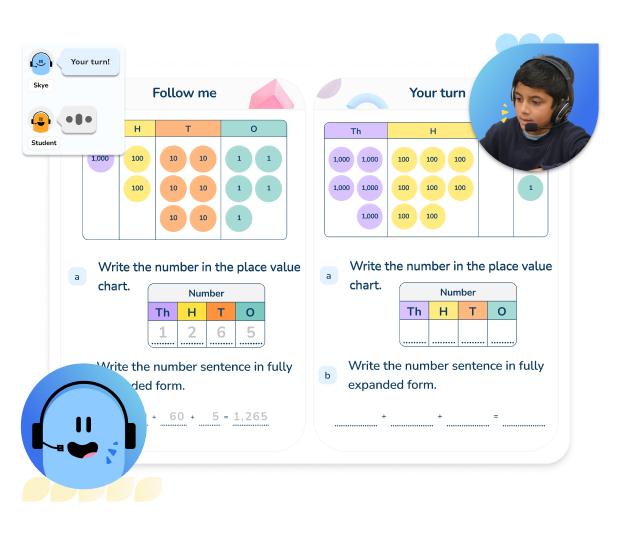
Topics in the Year 6 Maths national curriculum programme of study
- Number and place value
- Addition, subtraction, multiplication and division
- Fractions including decimals and percentages
- Ratio & proportion
- Algebra
- Measurement
- Geometry (properties of shapes)
- Geometry (position and direction)
- Statistics
The entire Year 6 curriculum for maths is available from gov.uk.
Free Year 6 Maths Worksheets and Tests
A collection of free Year 6 maths activities and worksheets from the Third Space Maths Hub. You need to register to download (but it's free). Use Google Chrome.
Download Free Now!Topics covered in Year 6 White Rose Maths scheme of learning work
White Rose Maths is used in approximately 80% of schools across the country. The Year 6 scheme of learning (SOL) outlines which topics are taught, and when, throughout the autumn, spring and summer terms of Year 6, so it might give you an idea of when and in what order Year 6 pupils will be learning different topics.
The breakdown for Version 3 of the scheme of learning is as follows
Year 6 autumn term
- Place value
- Addition and subtraction, multiplication and division
- Fractions A
- Fractions B
- Converting units of measurement
Year 6 spring term
- Ratio KS2
- Algebra
- Decimals
- Fractions, decimals and percentages
- Area, perimeter and volume
- Statistics and data handling
Year 6 summer term
- Themed projects, consolidation and maths problem solving
- Shapes KS2
- Position and direction
Understanding the changes in Key Stage 2 Maths from Year 5 to Year 6
The transition to Year 6 maths marks a crucial phase, acting as the final bridge before secondary school. While this year is heavily focused on consolidation of all the core skills pupils have developed throughout primary school, it’s not purely revision. The Year 6 maths curriculum also introduces significant new learning, particularly in areas like ratio, proportion, and algebra, ensuring pupils are fully prepared for success in secondary mathematics and later life.
Your final year strategy should balance the necessary revision of foundational concepts with the consistent practice of these newer, more complex ideas. This approach, alongside cultivating a mindful and positive attitude toward exams, is key. If you find your Year 6 maths pupils are feeling overwhelmed, remember that taking a break from traditional tests and worksheets can be highly effective. Integrating engaging and challenging maths games offers a brilliant alternative angle for reinforcing skills in a low-pressure environment.
Here are several articles sharing our best fun maths games, including KS2 maths games, KS1 maths games and KS3 maths games for all maths topics, including multiplication and division, and addition and subtraction, and a set of 35 times tables games you’ll want to bookmark whichever year group you teach!
Alternatively, educational apps such as DoodleMaths provide games based practice and feedback to parents and teachers and resources like online tools such as BBC Bitesize and Prodigy can reinforce learning outside of the classroom.
Number and Place Value in Year 6 Maths
In Year 6, number and place value simply extends the learning earlier down in the school. Numbers get bigger – from two-digit numbers all the way up to 10 million and smaller – to thousandths of a decimal place. In Year 6, children will be expected to read, write, order, compare and round numbers up to 10,000,000.
Discussing real-world large numbers with children improves their number sense. This is something that can be easily practised across the curriculum and using numbers out in every day life, for example population data and distances in geography and history, or even trying to reading out numbers cited in newspaper reports.
If you run into any challenges, one of the best tools for securing the concept of place value is this place value grid which is a cinch to make. Or you can try out these place value games and activities.
Addition, Subtraction, Multiplication and Division in Year 6 Maths
In Year 6, the four operations – addition, subtraction, multiplication and division – are taught together rather than in pairs. It is assumed by now that children understand the commutativity principle and that division is the opposite of multiplication and, subtraction is the opposite of addition.
Year 6 children learn about and use common factors, common multiples, and prime numbers as well as indices. In Year 6, pupils’ mental calculations improve quite significantly and they will need to perform much more complex maths in their heads.
Year 6 students use formal written methods for long multiplication and division and learn about the order of operations (BODMAS/BIDMAS).
One of the greatest challenges in this topic is likely to be Year 6 long division, to help you navigate this strand of division, you can use this guide on short and long division.
Here’s a snapshot of what’s involved…
Different division questions call for different methods of division to solve them, but here is a quick and easy guide to show which method a pupil should use and when:
- Chunking is best for smaller numbers and arithmetic.
- Short division is great for dividing larger numbers by one digit numbers.
- The long division method is handy for dividing large numbers by numbers with 2 or more digits.
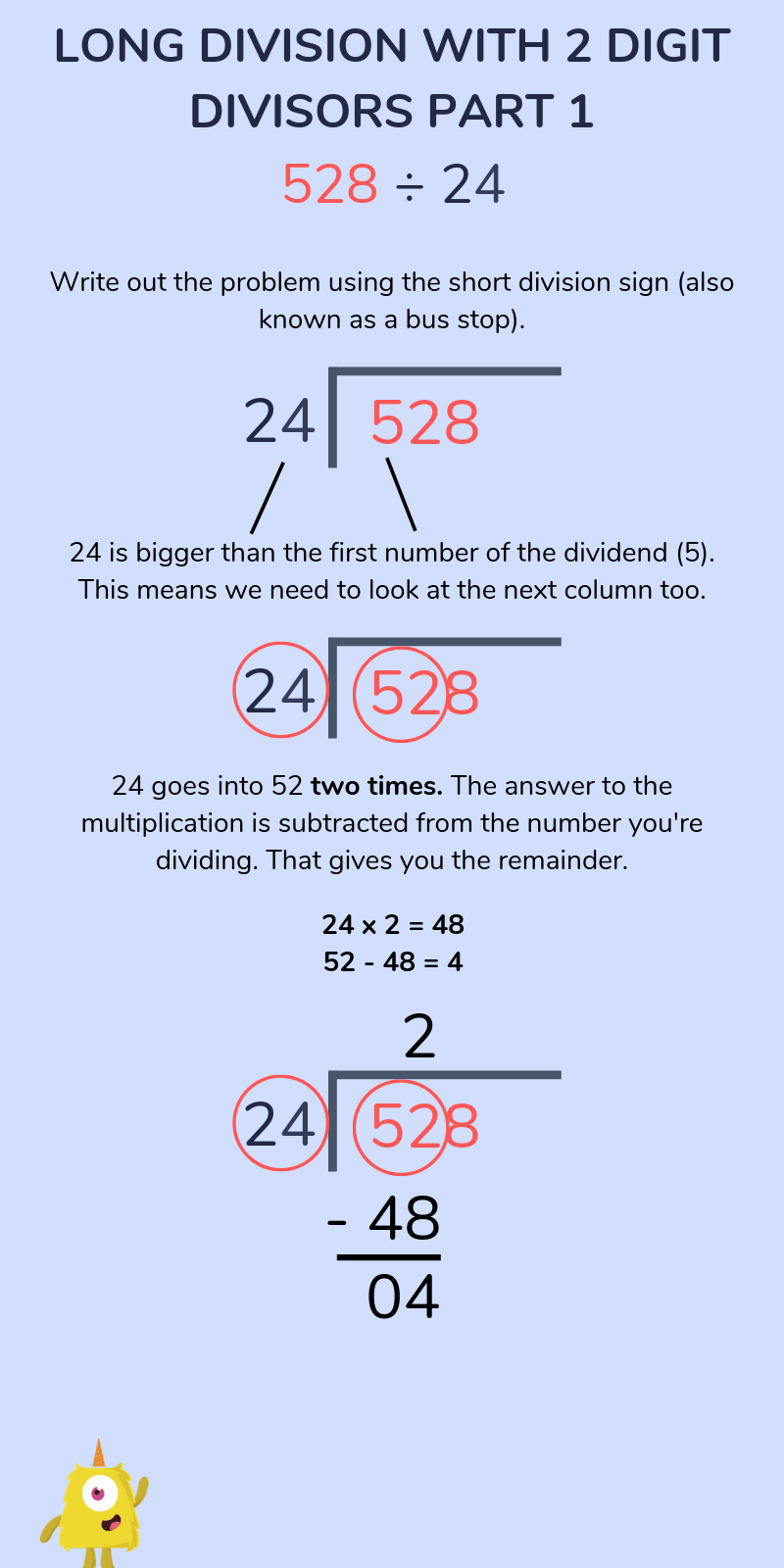
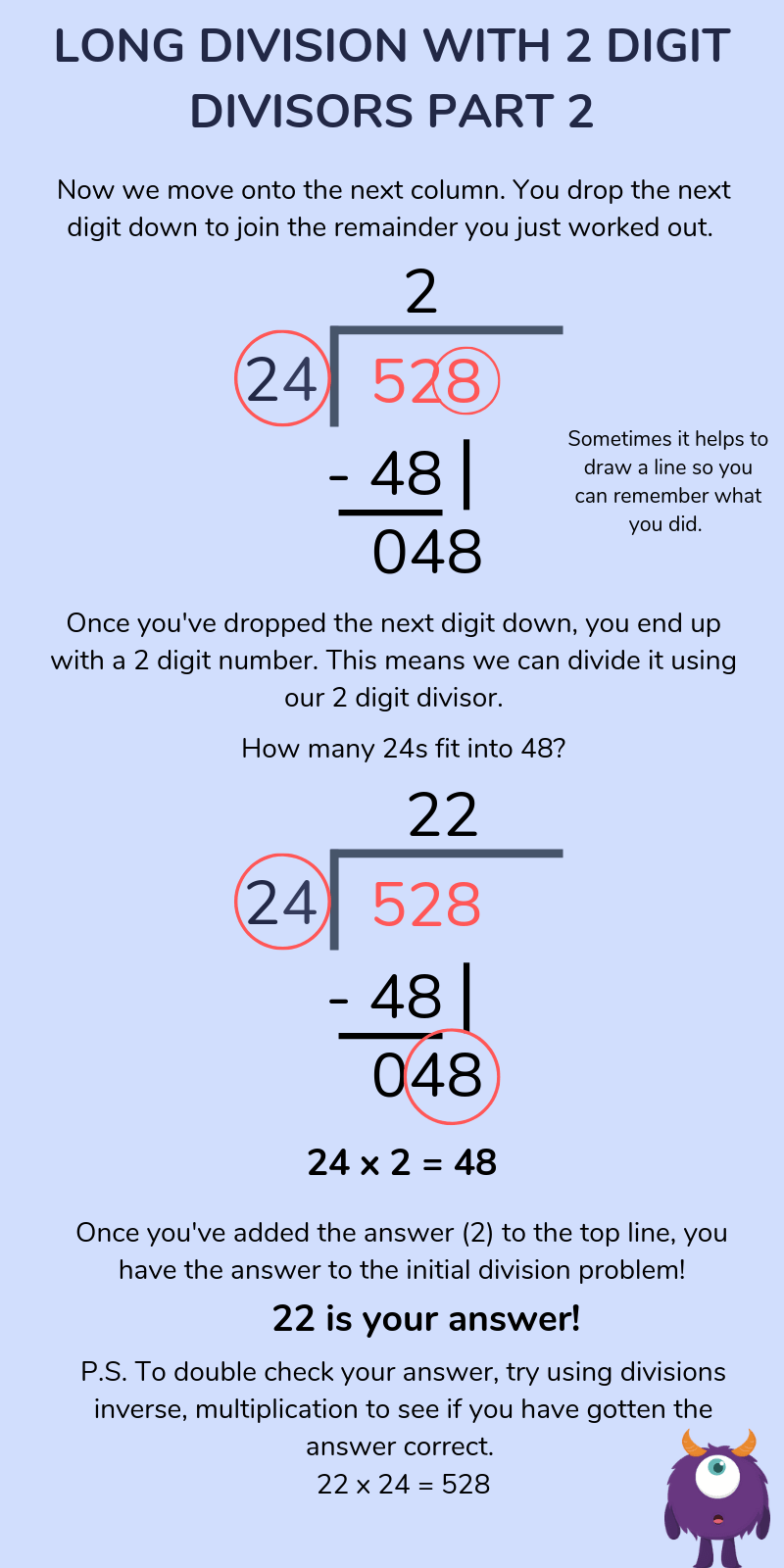
Fractions including Decimals and Percentages in Year 6 Maths
KS2 Fractions can prove a hurdle for many children even in Year 6. Fractions unleashes a world of new mathematical terms and processes such as equivalent fractions, comparing and ordering fractions, and writing fractions in their simplest form.
Simplifying fractions just means that we use the lowest possible numbers when we work them out, using our times tables and multiplication knowledge and division facts to reduce the size of the denominator and numerator.
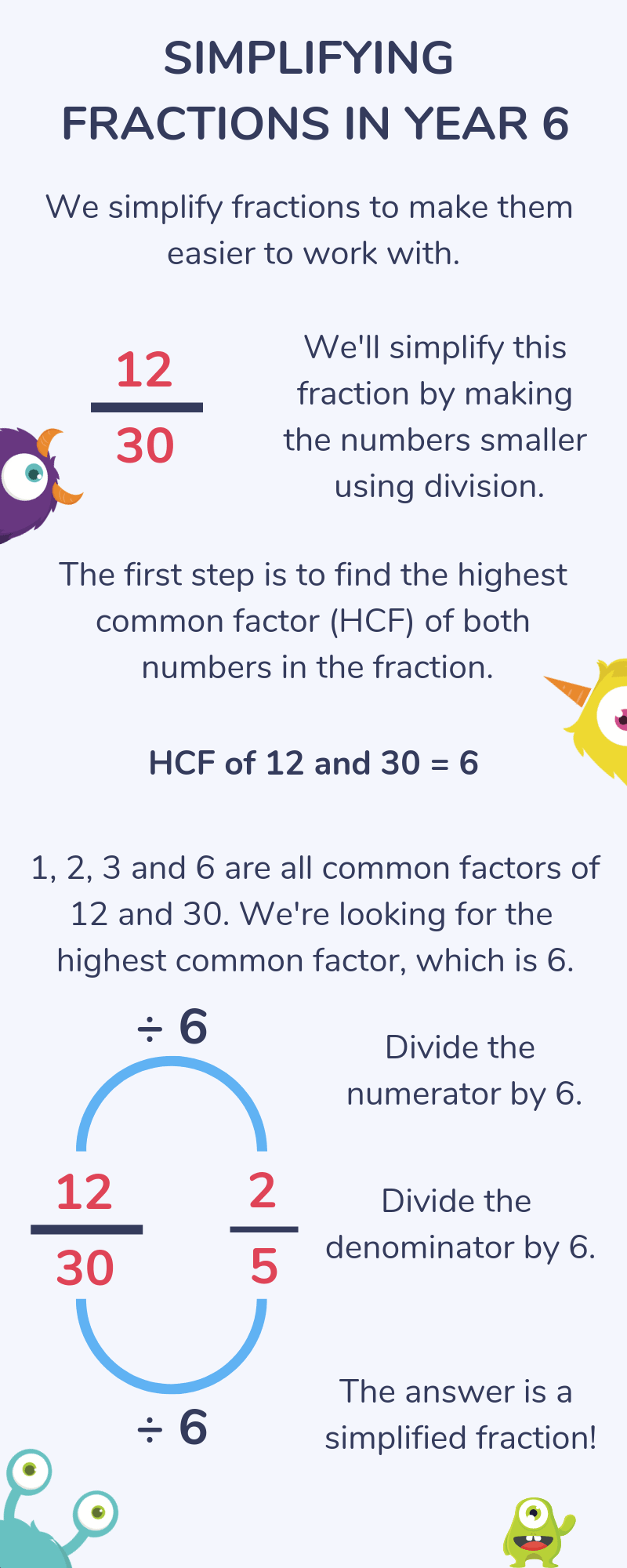
Children also learn subtracting fractions and how to work with mixed numbers and how to multiply fractions with different denominators.
By the end of Year 6, pupils must know how to convert fluently between the three forms:
- Fraction → Decimal: Divide the numerator by the denominator.
- Decimal → Percentage: Multiply the decimal by 100 (e.g., 0.79\times100 = 79 ).
- Percentage → Decimal: Divide the percentage by 100 (e.g., 87\div100 = 0.87 ).
- Percentage → Fraction: Write the percentage over 100 and simplify (e.g., 75\% = \frac{75}{100} = \frac{3}{4}).
For more detailed guidance on when and how to multiply and divide, read this article on comparing Fractions, Decimals and Percentages.
Ratio and proportion in Year 6 Maths
The national curriculum puts percentages of amounts and degrees etc. into the topic Ratio and Proportion in Year 6. This is a challenging topic as there are different methods and approaches and this may confuse children.
Effective methods for helping a Year 6 student excel in maths include making learning practical and fun through real-world applications, games, and interactive resources.
Students should practice maths through everyday routines and activities like cooking, shopping, and analysing sports statistics. Below are two simple Year 6 ratio activities we’d suggest to help pupils apply and practice their developing knowledge in Ratio and Proportion.
Year 6 Ratio activity: Dealing with discounts while sale shopping
Pupils could practise working out sale discounts.
For example, work out the price of an item with a 10% discount to begin with, before working your way up in multiples of 10% and 5%.
Year 6 Ratio activity: Baking recipes
Find a recipe that serves a lot of people and ask the children to think about how they can make the recipe the right size for you using division and fraction terminology (“We’ll need half/a quarter/an eighth of this recipe”).
An example of a maths question could be:
Last week you made a cake that had 8 slices. Unfortunately, this was too big and some of it had to be thrown away!
You want to make another cake this week, but you only need to use half the amount of ingredients.
Last week’s cake recipe:
- 220g butter
- 220g caster sugar
- 4 large eggs
- 300g flour
- 80g raspberry jam
Can you work out how much of each ingredient you would need to make a cake half this size?
Can you work out how much of each ingredient you would need to make a cake a quarter of this size?
To make a cake half the size, you need to divide the amount of each ingredient by 2.
To make a cake a quarter of the size, you need to divide the amount of each ingredient by 4.
| Ingredient | Original Amount (8 slices) | Cake half the size (4 slices) | Cake a quarter of the size (2 slices) |
| Butter | 220g | 110g | 55g |
| Caster Sugar | 220g | 110g | 55g |
| Large Eggs | 4 | 2 eggs | 1 egg |
| Flour | 300g | 150g | 75g |
| Raspberry Jam | 80g | 40g | 20g |
Algebra in Year 6 Maths
The Year 6 Algebra curriculum introduces pupils to foundational concepts that pave the way for secondary mathematics. While external support can be helpful, explicit instruction from the class teacher remains essential for securing these abstract skills.
The Year 6 (age 10–11) Algebra section of the National Curriculum is designed to introduce the foundational concept of algebra of using letters and symbols to represent variables and unknowns.
This is the first time pupils will begin learning Algebra formally as a distinct programme of study, though pupils will have encountered the underlying concepts in earlier years.
Pupils must be able to:
- Find pairs of numbers that satisfy an equation with two unknowns, e.g., finding all possible pairs of positive integers for a + b = 14 (such as a = 6, b = 8 or a = 1, b = 13).
- Use and apply simple formulae, e.g., using the formula A = l x w to calculate the area of a rectangle where the length (l) is 8 cm and the width (w) is 3 cm.
- Express missing number problems algebraically, e.g., solving x + 12 = 30 to find the value of the unknown x.
- Generate and describe linear number sequences, e.g., describing the rule for the sequence 3, 7, 11, 15… as “start at 3 and add 4”.
Measurement in Year 6 Maths
In Year 6, children will be expected to calculate and convert measurements with up to 3 decimal places. Children learn to convert units of measure, length, mass, volume and time from a smaller unit to a larger unit and vice versa. Also between imperial (miles) and metric units (kilometres)
As a refresher, these are the facts they’ll need to know:
| 10mm (millimetres) | = | 1cm (centimetre) |
| 100cm (centimetres) | = | 1m (metre) |
| 1000m (metres) | = | 1km (kilometre) |
| 1000g (grams) | = | 1kg (kilogram) |
| 1000ml (millilitres) | = | 1l (litre) |
| 1 kilometre | = | 5/8 mile |
They will also be looking at the volume of cubes and cuboids, and comparing area and perimeters of shapes such as parallelograms and triangles.
Year 6 Measurement activity: Understanding the area of a triangle
Calculating the area of a triangle, unlike a rectangle, requires pupils to grasp the concept of halving. This visual activity reinforces the fundamental relationship between a triangle and a quadrilateral of the same dimensions.
Cut and compare: A maths activity for Year 6
- Step 1: Draw a rectangle with integer side lengths on square grid paper.
- Step 2: Calculate the area of this rectangle.
- Step 3: From the top-left corner of the rectangle, draw a straight line (the hypotenuse) diagonally down to the bottom-right corner. This divides the rectangle into two identical right-angled triangles.
- Step 4: Carefully cut out one of the triangles.
- Step 5: Draw a non-right-angled triangle on a separate piece of grid paper, ensuring its base and height matches the rectangle’s dimensions.
- Step 6: Get the pupils to use the cut-out triangle from Step 2 to completely cover or “fill in” the empty space on the grid paper that surrounds the non-right-angled triangle from Step 3, effectively forming a complete rectangle.
- Conclusion: The fact that the initial rectangle was made of two identical triangles (Step 2) and that any triangle with the same base and height (Step 3) will always pair with another to form the same rectangle (Step 4) proves the formula. This ensures pupils understand that the formula for a triangle, A = \frac{1}{2} (b \times h), is derived from the formula for a rectangle or parallelogram.
Geometry (Properties of Shape; Position and Direction) in Year 6 Maths
The topic of geometry in Year 6 is split into two subtopics: shape and position and direction. The latter is mostly about plotting points on a quadrant so it’s important pupils know the difference between the x-axis (across) and the y-axis (up and down).
Shape can prove a little trickier. Geometry topics include drawing 2D shapes, recognising/building 3D shapes, and finding unknown angles in shapes. In Year 6, children will also compare and classify geometric shapes based on their properties and sizes and enlarge by scale factors.
They will do lots of angles work and start to use a protractor and work out where angles meet and what missing angles amount to. They’ll also start to understand parts of a circle, e.g., the diameter is twice the radius.
Year 6 Geometry activity: Protractor practice
Protractors are often a mystery to primary school age children, so frequent practice can help to clear these issues up!
A quick and easy way to practise handling a protractor, which can be done in class or at home, is:
- 1: Use a ruler to draw a few different sized angles on a sheet of paper.
- 2: Challenge your child to measure as many as possible in a minute.
- 3. Next, switch roles!
- 4: It’s your turn to measure as many angles as possible, in a different colour pen, for one minute.
- 5: Once all the angles are measured, go back and check for accuracy.
- 6: Whoever got the most angles right wins the game (and perhaps a small reward!).
While drawing angles might seem like straightforward maths for 10-year-olds, it constitutes the first steps towards secondary-level trigonometry.
Statistics in Year 6 Maths
In Year 6, children will interpret and present discrete and continuous data in a range of ways. Statistics in Year 6 involves interpreting line graphs and pie charts and calculating the mean average. Children use these to solve problems, as well as revising other forms of data representations from pictograms and line graphs to frequency tables. Using charts and graphs helps children interpret data more effectively.
If pupils are getting mixed up interpreting data, it’s a good idea to go back to basics and have a go at conducting a few surveys with the class before setting out the results in tables and graphs.
Year 6 Statistics Activity: Charting the Weather
Here’s a great activity to do in the rainy months (which shouldn’t be hard to come across in England!) to help with data interpretation through using a real-life example that even helps boost our science understanding.
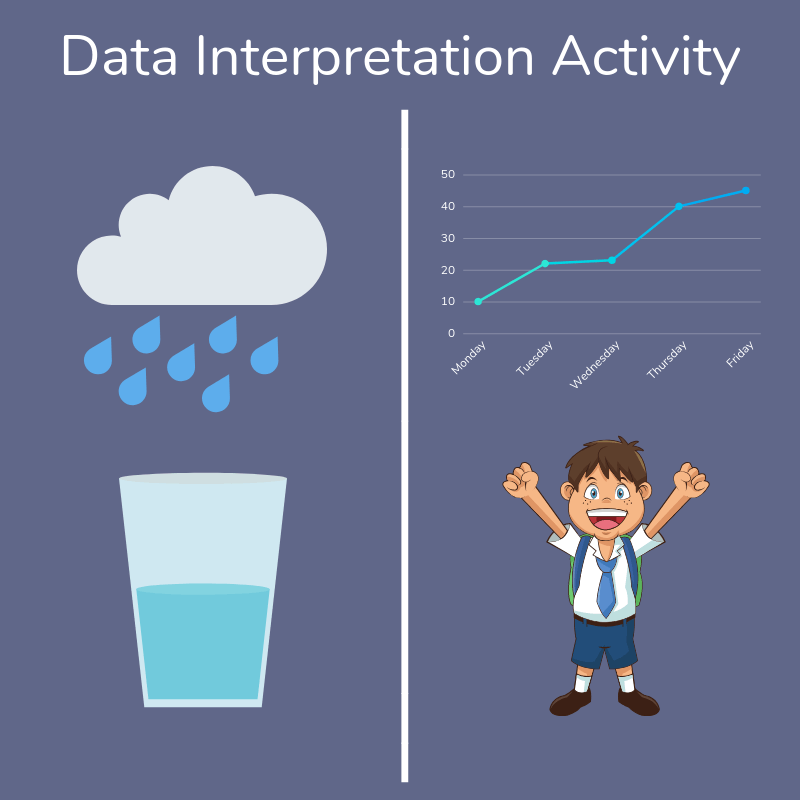
Dot Your Data
- Step 1: Pop a glass outside to collect water.
- Step 2: Measure the amount that falls each day.
- Step 3: Record the results in a table.
- Step 4: After one week, plot the results on a line graph.
Year 6 Statistics Activity: The mean birthday cake
This activity uses a relatable, real-life scenario – planning a birthday party – to introduce the concept of the mean average. Finding averages in real life helps children understand the concept of mean.
Costing the celebration
- Step 1: Provide students with the prices of the same size/type of birthday cakes from different retailers, or have students research themselves and record the data in a simple table.
- Step 2: Calculate the total combined cost.
- Step 3: Determine the mean average by dividing the total cost by the number of data points.
- Step 4: Discuss your findings with the class. Ask students: “Which shop’s price is closest to the mean? If you had a budget of £15, could you afford the mean cake? What does the mean tell us about the typical cost?” This helps them interpret the result.
Year 6 Maths…SATs, SATs, SATs…
When it comes to Year 6, mention of the SATs test is never far away.
For many children this age, the transition into a formal exam year can be stressful, so now is the time to practise working through challenges with a cool head.
Mathematics for children can be a minefield, and when everyone is talking about test scores and booster groups, it can be hard for pupils not to compare their progress against that of other children.
Remind your pupils that every child is different and the best approach will be to focus on your own learning instead of worrying about everyone else.
Read more about the KS2 SATS in the following guides:
The KS2 SATs in Maths consists of 3 papers:
- 1 Arithmetic Paper;
- 2 Reasoning Papers.
The latter tests 10 and 11 year olds ability to reason and problem solve using the maths knowledge and skills they have learnt at primary school. This is the aspect of KS2 maths that a lot of children find hard so the rest of this article gives you some ideas for how to help. You can find links to the official SATs past papers and mark schemes on the gov.uk website.
How to answer SATs reasoning questions
Most Year 6 pupils will practice answering SATs reasoning questions daily in class but often independently, which leaves a lot of room for misinterpretation.
It’s a good idea to provide pupils with a more systematic approach so they can approach questions confidently and also identify which questions they struggle with and why – is it the wording of the question, selecting the appropriate mathematical operation, or accuracy – or maybe a bit of everything?
Once you know which questions are problematic for your learners and why, you can work on a strategy to address this in time for the exams. Practicing reasoning questions at home can help identify which problems are challenging for your child so this can also be a helpful approach for parents too.
This method isn’t foolproof as the examiners are always thinking up new ways to trip children up but when faced with a problem that seems insoluble it’s worth having a strategy to fall back on. This is what we recommend.
1. Read the whole question
- Find words that you know.
- Find words that you don’t know. Can you work out what they mean from what’s around them?
2. Choose which tools to use
- Which operations make sense here? Addition, subtraction, multiplication or division?
3. Try out your tools
- Present work neatly so it’s easier to keep track later.
4. Check that the answer makes sense
- If it does, do a quick check of your work.
- If it doesn’t, work through the steps again.
Simple maths problems to work through with Year 6 pupils
Bill had three apples and ate two. How many did he have left?
Connor had £5. He spent £3 on lunch. How much money does he have left?
Rachel had 4 dogs. She bought 1 cat. How many pets does she have now?
Encouraging critical thinking by asking pupils to explain their reasoning helps develop problem-solving skills in maths.
Take the time to really dig into the process, and if pupils get it wrong, treat it as an opportunity to refine the process (rather than giving up).
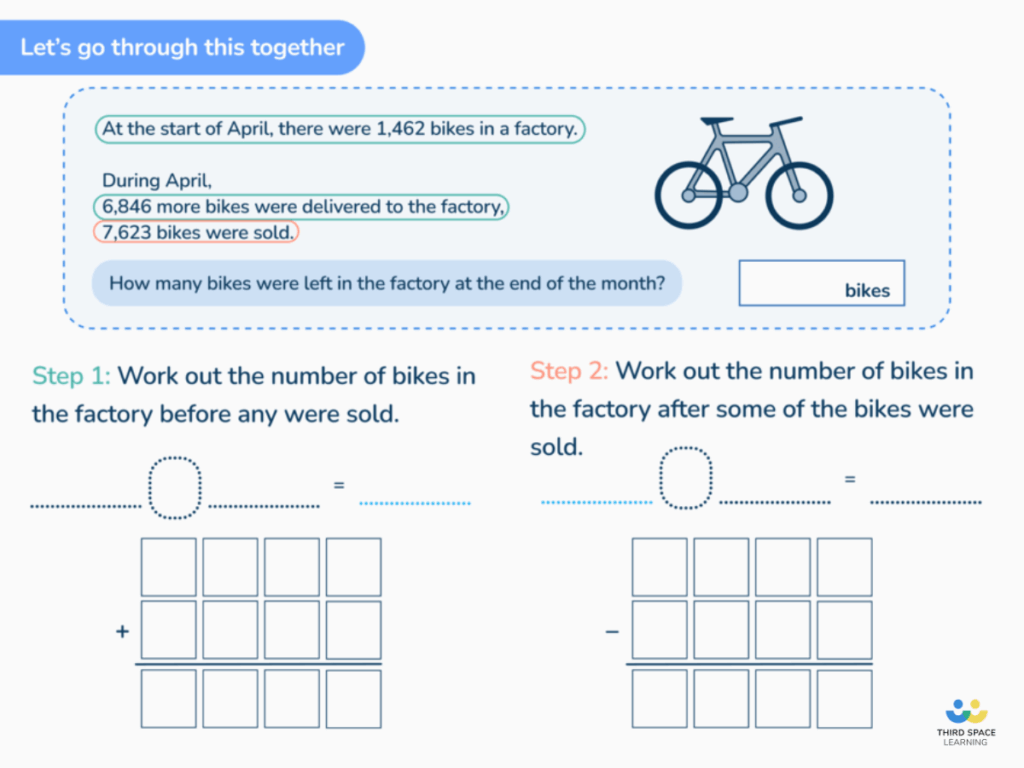
More complex multi step maths problems for Year 6 pupils
1. Potatoes cost £1.50 per kg and carrots £1.80 per kg. Jack buys 1½kg of potatoes and ½kg of carrots. How much change does he get from £5?Answer: £1.85
2. Wishy Washes car wash process 92 cars per day. They make £15 per car. How much money will they have made in 4 days.
Answer: £5,520
3. An aeroplane is flying from Birmingham to New York. The distance between these two cities is 5,400km. On the journey the pilot announces “We are 40% of the way through the flight.” How far has the aeroplane travelled?
Answer: 2,160 km
For more, see our blog on how to answer SATs reasoning questions and the Top 20 Year 6 Maths Revision Topics To Help Your Pupils Meet Age-Related Expectations and Achieve 100 in SATs.
Year 6 maths intervention: close attainment gaps in Fractions, Ratio & Algebra
Year 6 maths presents challenges for both pupils and teachers, often due to the cumulative nature of topics and the pressure of preparing for high-stakes assessments. Many pupils struggle with key conceptual building blocks like Fractions, Ratio, and Algebra, creating wide attainment gaps that are difficult to address in a busy whole classroom environment.
Third Space Learning’s AI maths tutoring with Skye provides targeted intervention specifically designed to close attainment gaps in complex Year 6 topics. The program uses an initial diagnostic assessment to pinpoint individual knowledge gaps and then delivers personalised, one-to-one lessons to ensure every pupil masters the fundamental concepts. We also have a Year 6 SATs Booster programme in which students work through maths SATs-style questions with Skye, building the skills and confidence needed for SATs success.
We used AI maths tutor Skye in the lead up to SATs this year. 93% of our Year 6 Third Space Learning pupils reached the expected level in their 2025 maths SATs. One child who had been struggling with maths attained at greater depth with a scaled score of 110.
Deb Harris, Assistant Headteacher, Wormley CofE Primary School, Hertfordshire
Also in this series…
- Year 3 Maths Curriculum Toolkit for 6 & 7 Year Olds
- Year 3 Maths Worksheets
- Year 4 Maths Curriculum Toolkit for 7 & 8 Year Olds
- Year 4 Maths Worksheets
- Year 5 Maths Curriculum Toolkit for 9 & 10 Year Olds
- Year 5 Maths Worksheets
DO YOU HAVE STUDENTS WHO NEED MORE SUPPORT IN MATHS?
Skye – our AI maths tutor built by teachers – gives students personalised one-to-one lessons that address learning gaps and build confidence.
Since 2013 we’ve taught over 2 million hours of maths lessons to more than 170,000 students to help them become fluent, able mathematicians.
Explore our AI maths tutoring or find out about primary school tuition for your school.
